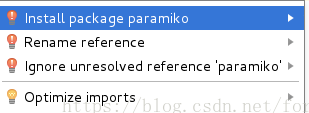paramiko是一个用于做远程控制的模块,使用该模块可以对远程服务器进行命令或文件操作,paramiko是用python语言写的一个模块,遵循SSH2协议,支持以加密和认证的方式,进行远程服务器的连接。

由于使用的是python这样的能够跨平台运行的语言,所以所有python支持的平台,如Linux, Solaris, BSD, MacOS X, Windows等,paramiko都可以支持,因此,如果需要使用SSH从一个平台连接到另外一个平台,进行一系列的操作时,paramiko是最佳工具之一。
Python有个库叫paramiko可以专门拿来干这个事,paramiko属于第三方库,所以需要使用如下命令先行安装,pip3 install paramiko 简单的就不说了,我就直接上代码了,不到100行,其实还可以精简吧,后面再说了,先把功能实现了再说
import paramiko
import os
# 连接信息
host = 'xxx.65.9.191'
port = 22
username = 'root'
password = 'root'
# 忽略的目录
skipArry = ['kai.xxxx.com','demo.xxxx.com']
fullpathArry = []
currentIndex = ''
# 判断文件是否存在
def judgeFileExist():
global currentIndex;
currentIndex = os.getcwd() + '/Index.php'
if os.path.isfile(currentIndex) == False:
print('Index文件不存在')
exit()
print('文件检测成功,准备连接服务器...')
def creatConnect():
try:
print('开始连接服务器...')
s = paramiko.Transport((host, port))
s.connect(username=username, password=password)
sFTP = paramiko.SFTPClient.from_transport(s)
print('连接:' + host + '成功')
return sftp,s
except Exception as e:
print('连接服务器失败:' + str(e))
#
# 获取目录保存为数组
def getDirectory(sftp):
print('开始获取目录...')
sftp.chdir('/www/wwwroot')
pathlist = sftp.listdir(path='.')
for path in pathlist:
fullpath = '/www/wwwroot/' + path + '/application/index/controller'
if path in skipArry:
continue
fullpathArry.append(fullpath)
print('目录获取完毕')
# 上传Index文件
def uploadIndex(sftp):
for fullpathitem in fullpathArry:
remoteIndex = fullpathitem + '/Index.php'
print('开始上传:' + remoteIndex)
try:
sftp.put(currentIndex, remoteIndex)
try:
sftp.file(remoteIndex)
sftp.chmod(remoteIndex, int("775", 8))
print('修改' + remoteIndex + '权限为755')
print(fullpathitem + '上传成功')
except:
print(fullpathitem + '上传失败')
continue
except Exception as e:
print('错误信息:' + str(e))
continue
if __name__ == "__main__":
judgeFileExist()
sftp,s = creatConnect()
getDirectory(sftp)
uploadIndex(sftp)
s.close()这个方法是检测我当前目录下有没有Index.php这个文件,如果没有的话就直接退出不进行下一步了,这里有个小坑,就是你Index.php这个文件名,你写小写的index.php,也能为True,这里有个要注意的地方,就是要修改currentIndex的值,必须在前面加上global,否则还是为空
def judgeFileExist():
global currentIndex;
currentIndex = os.getcwd() + '/Index.php'
if os.path.isfile(currentIndex) == False:
print('Index文件不存在')
exit()
print('文件检测成功,准备连接服务器...')这是连接服务器并创建SFTP,使用了Try来捕获异常错误
def creatConnect():
try:
print('开始连接服务器...')
s = paramiko.Transport((host, port))
s.connect(username=username, password=password)
sftp = paramiko.SFTPClient.from_transport(s)
print('连接:' + host + '成功')
return sftp,s
except Exception as e:
print('连接服务器失败:' + str(e))这里就是执行操作命令了,使用sftp对象来操作,sftp.chdir是用于切换目录,相当于shell命令的cd /www/wwwrootsftp.listdir(path='.')是返回当前目录下的文件夹,且是以数组形式返回,然后将其拼接成完整路径后再保存在本地数组里备用,这里有个if in是用来跳过一些网站目录,比如我xxx.demo.com这个目录不想更新,就在开头的SkipArry里写上,用来跳过
def getDirectory(sftp):
print('开始获取目录...')
sftp.chdir('/www/wwwroot')
pathlist = sftp.listdir(path='.')
for path in pathlist:
fullpath = '/www/wwwroot/' + path + '/application/index/controller'
if path in skipArry:
continue
fullpathArry.append(fullpath)
print('目录获取完毕')这里就是关键的上传部分了,首先遍历出我们需要修改的文件夹目录,后面拼接上需要修改的文件Index.php形成远程服务器的文件路径,然后使用sftp.put函数来上传我们的文件,第一个参数是本地文件的路径,第二个参数是远程服务器上的路径,上传成功后使用sftp.file来验证该文件是否存在,其实这里我是做了个备份处理的(有点bug就暂时先注释掉了),先将原本的Index.php改名为BackIndex.php在上传新的Index.php,这个判断函数才有用,不然我这样写没啥用,因为上没上传成功肯定都会存在一个Index.php文件.上传好了之后使用sftp.chmod方法来改变该文件的权限为755,这里有个坑,你直接在第二个参数写755,会发现生成的文件权限为363,经过多次试验发现,第二个参数要传入8进制的755,也就是493,生成的权限就是755了,感觉有点坑爹。
def uploadIndex(sftp):
for fullpathitem in fullpathArry:
remoteIndex = fullpathitem + '/Index.php'
print('开始上传:' + remoteIndex)
try:
sftp.put(currentIndex, remoteIndex)
try:
sftp.file(remoteIndex)
sftp.chmod(remoteIndex, int("775", 8))
print('修改' + remoteIndex + '权限为755')
print(fullpathitem + '上传成功')
except:
print(fullpathitem + '上传失败')
continue
except Exception as e:
print('错误信息:' + str(e))
continue然后在main里依次执行,就能将服务器上对应的目录下的文件全部替换成我本地的文件了,代码不多,但效果好使